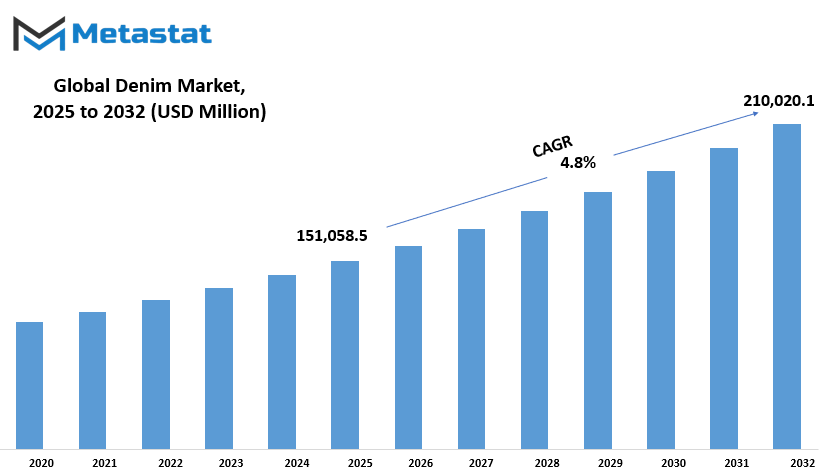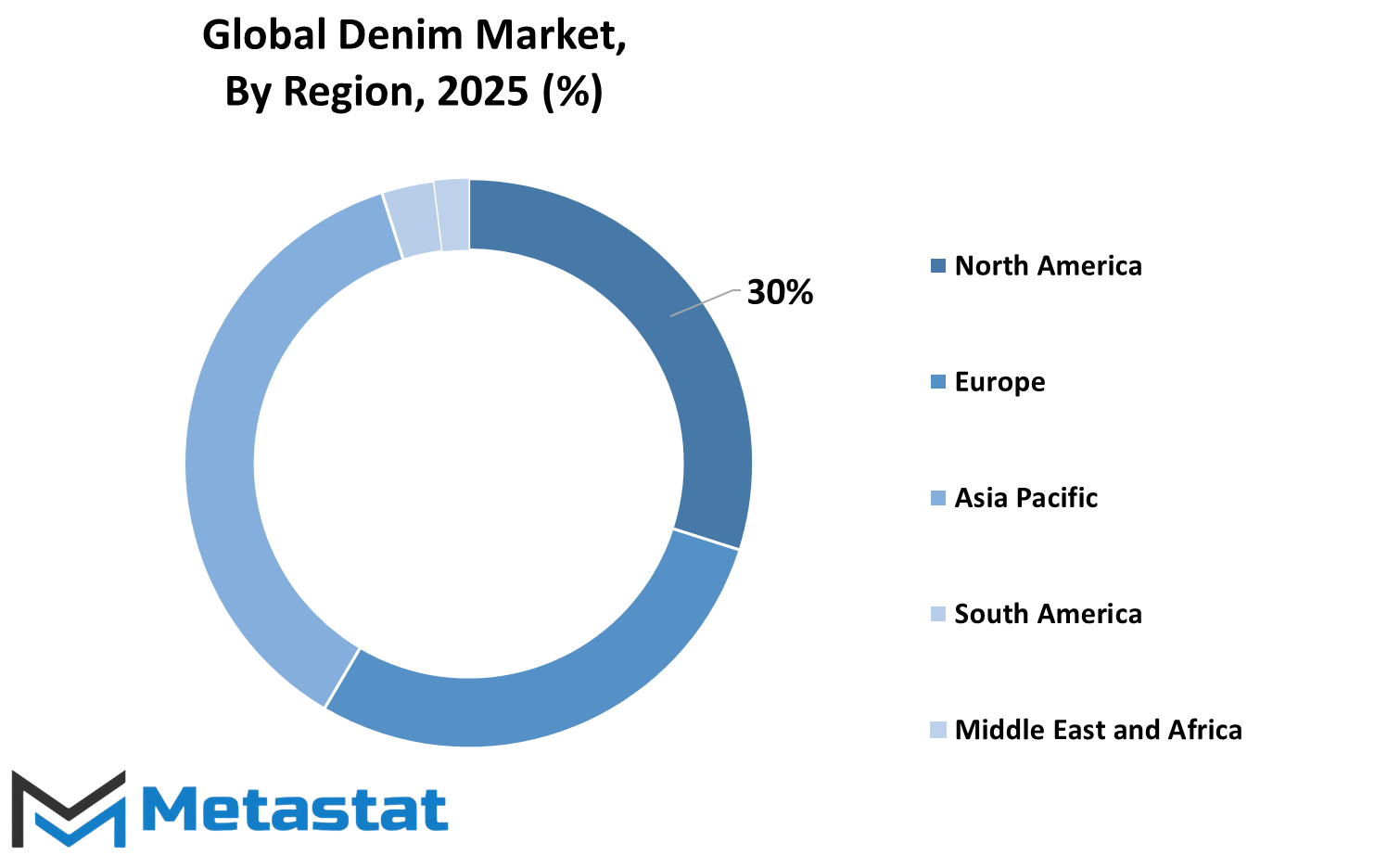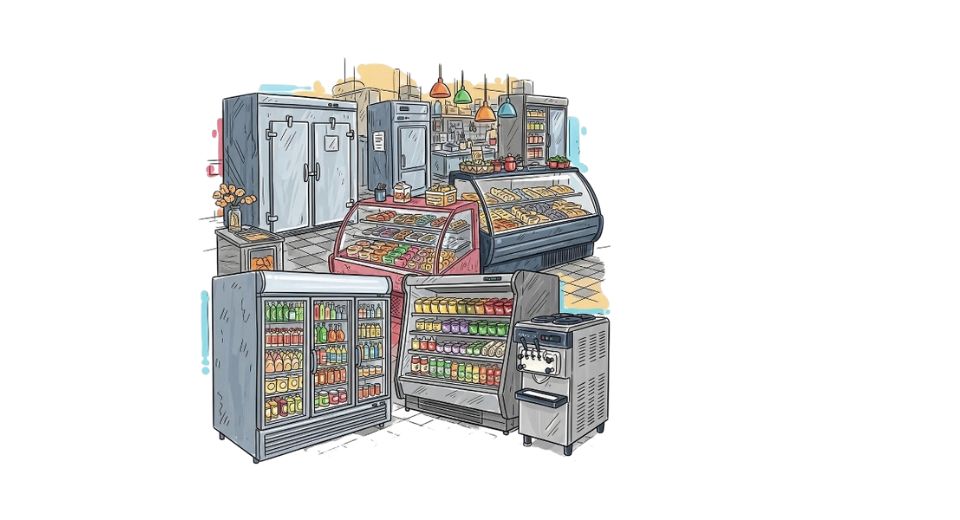MARKET OVERVIEW
The global denim market sits at a special crossroads in the larger textile and apparel sector, where tradition intersects with innovation in subtle yet profound levels. Denim, which was long a symbol of work clothing and hippie fashion, is on the cusp of stretching its identity far beyond its past connotations. Where most conversations revolve around sales volumes, manufacturing capacities, and export numbers, a more profound transition is quietly evolving one that will reframe what denim will stand for in the coming decade.
As global fashion stories evolve, the global denim market will start to seek new cultural crossroads. Denim is no longer a material; it will shortly be a signifier of hybrid expression. Designers from formerly non-dominant denim regions will be driving future collections, projecting their regional style into contemporary silhouettes. These global injections will reshape the way that denim is understood, produced, and consumed, directing it toward being a bearer of cultural narrative.
Digital change will take a subtle but grassroots role in transforming operations. As the spotlight today is thrown on automation and logistics, the lights in the future will be on how data intelligence will dictate the design itself. Trend forecasting backed by AI and virtual prototyping will soon dictate collections several months ahead of time, reducing wastage to the maximum while enhancing creative accuracy. The Global Denim industry won't just produce garments; it will pre-empt mood, taste, and tacit style shifts. This quiet repositioning will enable companies to skirt saturation and be contextually relevant.
Research in materials will also redefine traditional denim. Rather than merely combining elastane or employing recycled yarns, the next generation of denim will contain bioengineered fibers with targeted functional benefits. Fabrics that adapt to temperature alterations or modulate their structure based on wear patterns will start to appear. The Global Denim industry will shift its focus toward utility without undermining beauty value. These innovations will not be discussed exclusively as marketing hooks; they will represent actual-time requirement from new consumer sensibilities.
A major change will take place in consumer interaction. Denim brands and stores will invest in virtual try-on technologies and bespoke-fit platforms placing personalisation in the spotlight. This will not only improve the buying experience but nudge buying habits imperceptibly. International audiences will interact with denim in a manner that is an amalgamation of identity and individuality. The traditional mass production model will change to modular production, so mass customisation can be achieved without escalating operational costs.
Geopolitical trends will have subtle impacts on supply-chain decisions. As markets adjust to trade regimes and material shortages, firms will realign their supply chains to be resilient, not merely low-cost. The global denim market will diversify not just where denim is produced, but also how value is shared along the supply chain. This reallocation will impact labor relationships, engaging newer economies as players in denim centers.
In the years ahead, the Global Denim industry will no longer be reduced to cyclical fashion or simple silhouettes. It will increasingly assume a multidimensional presence a presence that is evidenced by design independence, material creativity, digital acuity, and increasing cultural engagement. It will not be flashy, but it will be enduring.
Global denim market is estimated to reach $210,020.1 Million by 2032; growing at a CAGR of 4.8% from 2025 to 2032.

GROWTH FACTORS
The global denim market is facing sweeping change as the apparel tastes of individuals are shifting towards informal and relaxed wear. Denim has become the favorite among individuals, especially because it goes well with most types of day-to-day appearances. This increasing demand is also highly driven by youth consumers who live in metropolitan cities and want to remain fashionable while feeling comfortable in their wear. As more and more individuals urbanize and become aware of global fashion, the need for denim increases. Denim is not only easy to wear casually but even semi-formally, which makes it a popular choice among individuals belonging to every generation and geography.
But there are issues in the market as well. The biggest one is the price element. Production of denim is extremely costly. From the acquisition of good cotton to dyeing and finishing the fabric, denim production is a capital-intensive venture. To that, raw materials' prices fluctuate, which puts pressure on the producers to keep costs in check without hurting the quality. This rise in costs can suppress the growth of small and medium businesses and deter new players from entering the market.
Another issue which cannot be ignored is the environmental price of denim production. Traditional techniques apply enormous volumes of water, and until recently, incorporated a number of chemicals that could potentially contaminate the local water and land use. As we consider these issues, manufacturers are scrutinized more than ever on how they can adopt better ways of producing denim, producing concern and urgency to create more environmentally friendly processes. And this need and pressure has pushed many brands to explore sustainable options, thus we can identify one of the greatest opportunities available to the market.
Today, as we contemplate organic and sustainable denim it is apparent the shift is open doors to new opportunities for larger brands and start-ups. We see that the majority of consumers searching for products are not only looking for items that are appealing to the eyes, but also justify their investment in their conscience. This shift has generated a demand for sustainable fashion and caused a boom in sustainable fashion, creating room for ethics and innovation. Along with this push we have witnessed an expansion of e-commerce and additional digital opportunities which have not only bolstered the existing businesses ability to leverage customer engagement in emerging markets, e-commerce operates as an inexpensive medium to penetrate into the fabric life cycle in previously unreachable territories. In sum, the global denim market is briming with opportunity driven by our modern lifestyle, growing fashion consciousness and a willingness to be sustainable.
MARKET SEGMENTATION
By Price Point
The global denim market continues to grow in a steady fashion, driven by growing demand across all price points. Denim is popular with ages and age groups, with many preferring its durability, practicality and timeless style. As fashions change and consumers want more qualitative practices and values in fashion denim has adapted its offer according to each price point and income groups: the ladder of price is very much the way that denim is made, sold, and consumed as it falls into Luxury, Mid-Tier and Low End price points, each with their own set of consumers, expectations and purchasing ability.
The Luxury denim market is worth $43,513.6 million and captures consumers who value quality first, distinctive design, and brand name. These consumers tend to be brand loyal and are willing to pay extra for workmanship, exclusive cuts, or restricted collections. They are seeking jeans that have both style and social standing. This sector funds niche brands and designer collaborations, which contributes to the prestige and premium price points.
Mid-Tier segment appeals to customers who desire quality at an affordable price. They prioritize comfort, fit, and fashion without incurring high costs. They are brand-conscious but receptive to newer or smaller brands. This segment tends to find value between affordability and fashion sense, thus appealing to a broad section of people from working professionals to fashion-forward teenagers. Most successful brands in this category do well by providing fashionable products at affordable prices.
Low End is the cheapest and targets price-conscious customers who value function over fashion. These shoppers might purchase denim for everyday purpose, and it tends to be something easily available and inexpensive. The emphasis is on basic requirements in this case, and the denim tends to be retailed at mass-market retailers. Buyers in the developing world and those seeking value packages fall under this category.
Overall, the global market for denim mirrors shifts in consumer patterns, economic realities, and fashion trends. Success is achieved by the brands that comprehend the requirements of each segment and provide goods that correspond to what they expect. While Luxury denim gains attention due to exclusivity and brand, the Mid-Tier and Low End segments create volume and address the day-to-day wear requirements of millions. Every price level plays an integral part in determining the overall growth and trajectory of the denim market.
By Distribution Channel
The global denim industry has been experiencing consistent growth through the years, influenced by shifting fashion trends, comfort, and consumer preferences for adaptable clothing. One of the main ways the industry is organized is via its distribution channels. These channels are imperative to the way denim products get to the customers and affect the purchase experience. Every distribution form provides a different means of brands reaching individuals and fulfilling their expectations.
Retail outlets are perhaps one of the most prevalent and traditional methods denim is offered. Online stores, however, have also expanded over the past few years. With the development of e-commerce, people are now more at ease purchasing clothing on the internet. Online platforms provide many options of clothing from various companies and enable individuals to compare prices, read reviews, and make purchases anytime. Though sizing remains an issue, most online retailers now offer detailed size guides, simple returns, and virtual fitting capabilities to assist customers in making the correct choice.
Wholesale distribution is another significant technique in the denim industry. In this strategy, the manufacturers produce high volumes of denim and sell them to other enterprises, like departmental stores or third-party outlets. This enables brands to access higher volumes of consumers without controlling each sale in-house. It facilitates reaching various parts of the country more rapidly and at lower expense.
Factory outlet stores have also become popular among cost-conscious consumers wanting quality denim at an affordable price. The outlets carry past collections or excess inventory at reduced prices and thus are an ideal choice for budget shoppers. They assist brands in liquidating inventory while retaining some profit.
Finally, other distribution channels such as pop-up stores or neighborhood markets also share in the total denim market. These channels are usually employed for brand awareness, testing new product lines, or targeting specialized customer segments.
Together, every distribution channel contributes to the success of denim brands globally. By knowing what the buyers need and applying the correct techniques to reach them, businesses can go on to expand and remain relevant in a competitive industry.
By Type
The denim industry has the most consistent growth on a global level. Mostly due to emerging fashion trends, rising disposable income, and increasing need for casual and comfortable clothing. Denim has grown beyond just the main fabric for jeans, and is not categorized under a variety of clothing styles, thus representing style, comfort, versatility, etc. Its popularity as a wardrobe staple is universal between regions and ages, and particularly youth driven, making it a trend that anyone can tap into. Brands have reacted to this emerging popularity by launching collections targeting both mass and premium segments with additional options around design, fit, and functionality.
On a typological level the market is split between TopWear and Bottom wear. TopWear is denim jackets/shirts/vests and Bottom wear is typically jeans/skirts/shorts. Jeans are still the best category by sales but denim TopWear is seeing increasing popularity especially in large urban areas because layering and mix-and-match styles were becoming commonplace. Today's customers want both comfort and fashion and denim checks those boxes. The wear and durability of the fabric also makes it the top choice of apparel, especially when looking for day-to-day apparel. This involves using minimal water, minimizing chemical usage, and recycling materials. Not only do these efforts attract green-conscious consumers, but they also raise the bar for responsible manufacturing in the industry.
Online retailing and digital advertising have also contributed significantly to the expansion of the denim industry. Social media outlets have a huge impact on fashion trends, setting styles that rapidly become popular throughout regions. Consequently, companies are concentrating on providing up-to-date designs and limited drops that generate buzz and sell. Browsing collections online and having them delivered at home makes denim more accessible than ever.
In summary, the global denim market keeps on growing as companies innovate and shoppers combine tradition and modernity. With new lines, better fits, and an increasing emphasis on sustainability, denim remains a top and consistent choice in fashion. Whether as TopWear or Bottom wear, its popularity does not seem to lessen.
By Color
The global denim market is a large sector of the fashion industry that has a diverse range of options to consumers. One of the most usual divisions of this market is based on color. There are three main divisions which are light denim, medium denim and heavy denim. Each has its own appeal and represents a different direction for moving trends and consumer interests.
Light denim has been very popular amongst people who prefer a more relaxed and casual look. Light denim is worn most often in casual clothing, like jeans, jackets, and shorts. The light colored denim looks relaxed and laid-back, and is favoured in seasons like summer or spring when individuals are most relaxed. Most brands have light denim in their lines in order to represent a relaxed and casual look. It is also easy to mix with other colours which is why it is preferred by young adults and anyone who wants a casual wardrobe.
Medium denim is more versatile. It has an even appearance, neither too light nor too dark, and so is appropriate for both casual and semi-formal outfits. It's frequently selected by customers seeking something appropriate for many occasions. Whether it is an informal meeting or a office day, medium denim allows individuals the liberty of dressing up or down without altering the essence of their wardrobe. This color continues to be one of the most bought kinds because of its versatility and capacity to remain trendy irrespective of the season.
Heavy denim, being darker in color, is traditionally applied to more defined or tougher fashion. Its darker tone offers a crisper and more refined appearance. Heavy denim is usually favored for autumn and winter fashion because it blends well with heavier material and darker colors. Heavy denim is also frequently associated with traditional or business designs. Individuals who enjoy a bold, assertive look tend to choose heavy denim since it conveys a more serious demeanor.
With fashion evolving all the time, the international denim industry continues to adapt to the demands of their consumers. Providing light, medium, and heavy denim, the industry makes sure there's something for all. Color is a major factor in what individuals wear, and the recognition of these categories makes it easier for brands as well as buyers to make informed choices. Every form of denim contributes to the industry as a whole by catering to various requirements and tastes.
|
Forecast Period |
2025-2032 |
|
Market Size in 2025 |
$151,058.5 million |
|
Market Size by 2032 |
$210,020.1 Million |
|
Growth Rate from 2025 to 2032 |
4.8% |
|
Base Year |
2024 |
|
Regions Covered |
North America, Europe, Asia-Pacific, South America, Middle East & Africa |
REGIONAL ANALYSIS
The global denim market is segmented on a regional basis: North America, Europe, Asia-Pacific, South America, and comes the Middle East & Africa, basically subdividing them into regions, countries, and territories. In North America, we have the U.S., Canada, and Mexico, which is huge considering that the denim trends from these denote the direction of certain trends, since one of these is one of the largest consumers of denim in the world, while Canada and Mexico also remain demand holders in denim due to a growing fashion industry and a prevalent young and growing population.
Countries in Europe are also segmented into the UK, Germany, France, Italy, and the rest of Europe. These geographic areas are renowned for being leaders in fashion, and have a long history for showing keen inclinations toward wearing denim. From traditional jeans to the new wave of trendy eco-friendly denim designs, the driver in this market is undoubtedly represented in tradition as much as in innovation. Germany and France have been leaders in the growing demo of green denim products, while Italy has become synonymous with high-end denim and impeccable craftsmanship synonymous with premium denim. Finally, rest of Europe is also a constant contributor to the demand story with denim being a bread-and-butter staple of the majority of everyone's wardrobe.
The Asia-Pacific region consists of India, China, Japan, South Korea, and Rest of Asia-Pacific. This region represents a vast consumer base and important producer of denim. Production and consumption is dominated by China and India, but both urbanization and increasing disposable incomes are undoubtedly stimulating growth in demand. Japanese and South Korean consumers are perhaps the most fashion-conscious, and interest in denim focuses primarily on style, quality, and/or premium denim. The Rest of Asia-Pacific is contributing to market growth simply on the premise of natural curiosity, where western fashion is gaining increasing traction in terms of market interest.
The South American region consists of Brazil, Argentina, and the Rest of South America. In terms of population and fashion-conscious culture, Brazil is a principal import and export market for denim globally. Argentina is still maintaining a consistent trajectory of denim interest, with domestic brands gaining more and more traction with consumers. As a market, this region is definitely growing, especially with younger consumers.
The Middle East & Africa region is comprised of GCC Countries, Egypt, South Africa, and Rest of Middle east & Africa. Growth is slow in this market, however, demand for comfortable, stylish denim continues to steadily grow in the likes of the UAE, Saudi Arabia, as well as Egypt and South Africa, with their expanding fashion retail markets. As more and more consumers of the Middle East & Africa pursue casual, but fashionable income-based clothing, such as denim, it is only a matter of time before growth hastens.

COMPETITIVE PLAYERS
The global denim market continues to grow steadily, fuelled by shifts in fashion, consumer demand, and the effects of social media and celebrity culture. Denim has been a staple in wardrobes globally as it is comfortable, durable, and can be casual or semi-formal. Throughout time, people have pushed boundaries and tried out new colours, cuts and styles of denim which has made brands create in order to meet that demand. What once was workwear, has become a fashion statement for people of all ages. The total versatility of denim is appealing to people from all demographics, whether they are looking for something stylish, practical, or both .
Many companies hugely impactful in impacting the denim industry. World-renowned brands such as AEO Management Co, Outfitters, Ariat International, Inc., Giorgio Armani S.p.A., ASOS, C&A Mode GmbH & Co. KG, Calvin Klein, Diesel SpA, Frame, G-Star Raw, The Gap, Inc., Good American, Guess Inc. and Hugo Boss have produced numerous denim products. Companies themselves are predominantly now producing jeans based on the current wants of the customers either if it is comfort, style or fashion.
As fashion trends change, denim brands change their collections to remain popular. Inditex, the parent company of popular brands such as Zara and Pull and Bear, is famous for releasing trendy denim styles into the market in no time. Brands such as Jack & Jones, Lee, Marks and Spencer plc, and Mother Denim also keep attracting customers by providing trendy and classic denim options.
Other retailers such as New Yorker, Next Retail Ltd., NYDJ Apparel, LLC., Old Navy, ONLY, Pepe Jeans, Primark Limited, Ralph Lauren Media LLC, River Island, 7 For All Mankind, and Target Corporation have also contributed tremendously. They all have their own style of denim, whether in terms of fit, design, price level, or marketing messages. With so diverse a collection of players in the denim market, the competition is fierce, and firms are constantly looking for ways to differentiate. Through green methods or cutting-edge design, the aim is ever more to provide customers with more of what they need. Denim is no longer an everyday staple it is a statement of personal taste and remains a significant component of the fashion industry.
Denim Market Key Segments:
By Price Point
- Luxury
- Mid-Tier
- Low End
By Distribution Channel
- Retail Stores
- Online Marketplaces
- Wholesale Distribution
- Factory Outlet Stores
- Others
By Type
- Topware
- Bottomwear
By Color
- Light Denim
- Medium Denim
- Heavy Denim
Key Global Denim Industry Players
- AEO Management Co
- Outfitters
- Ariat International, Inc.
- Giorgio Armani S.p.A.
- ASOS
- C&A Mode GmbH & Co. KG
- Calvin Klein
- Diesel SpA
- Frame
- G-Star Raw
- The Gap, Inc.
- Good American
- Guess Inc.
- Hugo Boss
- Tesco
- Tommy Hilfiger Licensing, LLC
- True Religion Brand Jeans
- Wrangler
- H & M Hennes & Mauritz AB
- BRAX Store GmbH & Co. KG
- MAC Mode GmbH & Co. KGaA
- J Sainsbury PLC
- Levi Strauss & Co.
- URBN.com (Anthropology)
- Costco Wholesale Corporation
- Rock-Republic
- Mango
- Uniqlo (Fast Retailing Co., Ltd.)
- VF Corporation
- Shein
- Inditex (Zara, Pull and Bear)
- Jack & Jones
- Lee
- Marks and Spencer plc
- Mother Denim
- New Yorker
- Next Retail Ltd.
- NYDJ Apparel, LLC.
- Old Navy
- ONLY
- Pepe Jeans
- Primark Limited
- Ralph Lauren Media LLC
- River Island
- 7 For All Mankind
- True Religion Brand Jeans
- Wrangler
- H & M Hennes & Mauritz AB
- BRAX Store GmbH & Co. KG
- MAC Mode GmbH & Co. KGaA
- J Sainsbury PLC
- Costco Wholesale Corporation
- Rock-Republic
- Mango
- Uniqlo (Fast Retailing Co., Ltd.)
- VF Corporation
- Shein
- Target Corporation
WHAT REPORT PROVIDES
- Full in-depth analysis of the parent Industry
- Important changes in market and its dynamics
- Segmentation details of the market
- Former, on-going, and projected market analysis in terms of volume and value
- Assessment of niche industry developments
- Market share analysis
- Key strategies of major players
- Emerging segments and regional growth potential








 US: +1 3023308252
US: +1 3023308252






